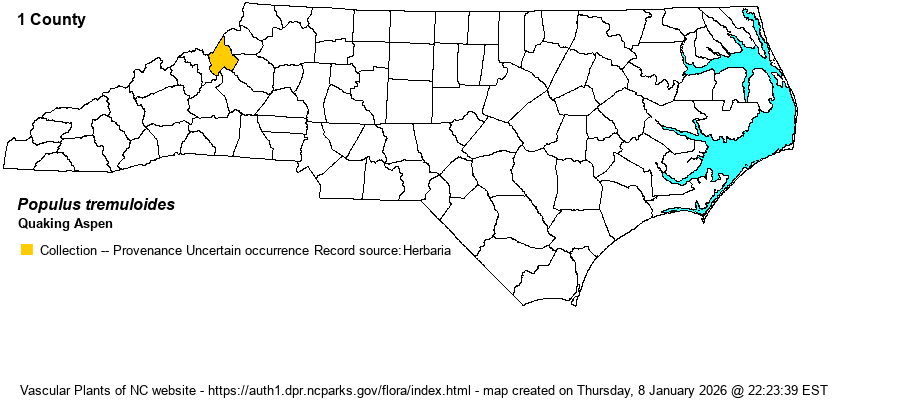| Author | Michaux | |
| Distribution | Known conclusively only from near the top of Grandfather Mountain in Avery County. However, as this is a considerable southern disjunction from the rest of the range (the Mountains of central VA), it is not clear if it is native to NC. At least, if a native population were to occur in NC, it should be from high and rocky elevations in the northern Mountains, where Grandfather Mountain is located and has suitable habitats. The fact that the collections came from the access road margin also gives pause to its native status. In March 2022, Sorrie reviewed all specimens in SERNEC. None of them appear to be a native occurrence: "margin of road, vicinity of tower, Grandfather Mtn."; "1.7 miles S of Linville, vicinity of Gardens of Blue Ridge". Interestingly, another Avery Co. specimen was taken in 1971 from a "nursery" in nearby Pineola. Henderson County specimens, all from the French Broad River, are labeled/annotated as tremuloides, grandidentata and a hybrid between the two.
This is a northern and western species, widespread across Canada and the western U.S. It ranges south to the mountains of VA and WV, and to northwestern NC, where of uncertain provenance. | |
| Abundance | Very rare, if still present; only from high elevations. A few specimens were collected from one or more plants along the access road to Grandfather Mountain, in 1990. Any other records are certainly of non-natural populations. The NC NHP does not have the species on its Rare List or Watch List. However, Weakley (2018) considers it to be possibly native in NC; thus, this website has given it a W4 Watch List status, with Avery County shown on the map below as being of Provenance Uncertain. | |
| Habitat | In NC, the species is found or to be expected only at high elevations in dry, rocky or otherwise exposed situations, such as along wooded borders, rocky summits, or clearings. |
| Phenology | Flowers and sets seed from March to May. | |
| Identification | This is one of the most common and familiar trees in North America, and it is hard to overlook in Canada, border states, and most of the western states. It is a small to medium deciduous tree, growing to 40-60 feet tall on average. It is very easy to identify by its nearly rounded leaves, about 2-2.5 inches long, with slightly serrated margins. Because it has very long (often 1.5-2 inches), flattened petioles, the leaves twist and turn in the slightest breeze, giving it the common name of Quaking Aspen. It also has smooth and white to very pale gray bark, making a grove of the trees easy to spot at a distance. | |
| Taxonomic Comments | None
| |
| Other Common Name(s) | Trembling Aspen, American Aspen, and a few others | |
| State Rank | [SE?] | |
| Global Rank | G5 | |
| State Status | [W4] | |
| US Status | | |
| USACE-agcp | FAC link |
| USACE-emp | FAC link |

